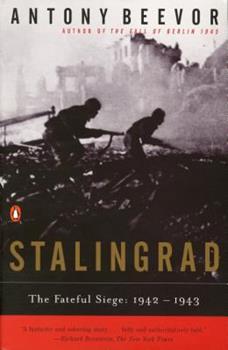 I’ve only read a handful of history books (crime fiction is my passion) but they’ve all be great reads. A Distant Mirror: The Calamitous 14th Century; Battle Cry of Freedom: The Civ89l War Era; Nothing Like It In the World: The Men Who Built the Transcontinental Railroad 1863-1869; and Wires West: The Story of the Talking Wires. I’m currently reading STALINGRAD The Fateful Siege: 1942-1943 by Antony Beevor.
I’ve only read a handful of history books (crime fiction is my passion) but they’ve all be great reads. A Distant Mirror: The Calamitous 14th Century; Battle Cry of Freedom: The Civ89l War Era; Nothing Like It In the World: The Men Who Built the Transcontinental Railroad 1863-1869; and Wires West: The Story of the Talking Wires. I’m currently reading STALINGRAD The Fateful Siege: 1942-1943 by Antony Beevor.
(Wikipedia) “Stalingrad is a narrative history written by Antony Beevor of the battle fought in and around the city of Stalingrad during World War II, as well as the events leading up to it. The book starts with Operation Barbarossa, the German invasion of the Soviet Union in June 1941 and the subsequent drive into the Soviet Union. Its main focus is the Battle of Stalingrad, in particular the period from the initial German attack to Operation Uranus and the Soviet victory.”
Before television brought wars into our living rooms, we watched newsreels when we went to the movies. A mix of propaganda and news but fascinating to see as I read Beevor’s book. The German super-soldier didn’t look so super in these newsreels. The generals who had soldiers shot if they even thought about surrendering, were quick with the white flag for themselves.
I have been surprised by how little I actually learned in school about this historic battle (and WWII for that matter). I underlined a lot of passages from this book. Too many to go back and transcribe. Here are few I captured during the read (not in order). The first one is a description of Hitler’s advanced headquarters at the Ukrainian town of Vinnitsa (1942).
“The effort and attention to detail, when serving the Führer’s needs and safety, were reminiscent of a Byzantine court. Before he arrived, Gestapo teams searched the walls for microphones and explosives. A large vegetable garden was organized by a German horticultural firm, Zeidenspiner, and dug by the Tod Organisation. Hitler’s personal chef, Hauptsturmführer Fater, had to go out to select the vegetables himself. Any other vegetable destined for the Führer’s plate had to be dug up under the eye of an appointed courier who then brought the produce direct to the kitchen. All the food was chemically analysed before cooking, and sampled by a taster before it reached his plate. Samples from the water supply also had to be checked several times a day. Mineral water was bottled in the presence of couriers, and brought in. Even the laundry was X-rayed to ensure that no explosive had been concealed. Oxygen tanks were stored outside the bunker ready to pump in air, because Hitler was afraid of noxious vapous from the ferroconcrete. The Gestapo supervised the filling of the tanks and tested them regularly.”
“(Stalin) proposed the execution of 50,000 Wehrmacht officers to destroy German military power for good. Churchill stood up angrily and declared that the British people would never stand for such mass murder’. Nobody should be shot without a proper trial. He walked out. Stalin, amused at the reaction he had provoked, went after him. Placing both hands on his shoulders, he claimed that he had been joking and cajoled Churchill into returning.”
“Stalingrad Academy of Street Fighting”: “They armed themselves with knives and sharpened spades for silent killing, as well as sub-machine-guns and grenades. (Spades were in such short supply, that men carved their names in the handle and slept with their head on the blade to make sure that nobody stole it.)
In the 24th Panzer Division, for example, Captain von Rosenbach-Lepinski is said to have told his motorcycle reconnaissance battalion: ‘The war with Russia will last only four weeks.’”
“Four million (Russian) people volunteered or felt obliged to volunteer for the opolchentsy militia. These untrained soldiers, often without weapons and many still in civilian clothes, were sent against the Wehrmacht panzer formations. Four militia divisions were almost complete annihilated before the siege of Leningrad had even begun.“
“Casualties had been higher than expected – over 400,000 by the end of August – and the wear and tear on vehicles far greater than predicted. Engines became clogged with grit from the dust clouds, and broke down constantly, yet replacements were in very short supply. Bad communications also took their toll. The railway tracks, which were a slightly broader gauge, had to be relaid, and instead of the highways marked on their maps, the armies found dirt roads which turned to glutinous mud in a brief summer downpour.”
“The Führer, however, kept his generals in order by exploiting their rivalries and disagreements.”

Last night I watched a very long (almost three hours) but very interesting film on the battle of Stalingrad (and the aftermath). From the Amazon Video page: “Filmed from both German and Russian perspectives, the series contains footage shot by soldiers during the siege. The film is three documentaries (THE ATTACK, THE KESSEL, and THE DOOM).